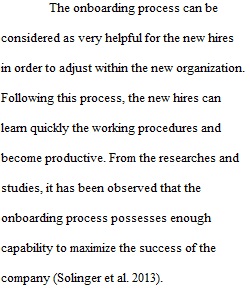


Q YOUR TASK Your task is to create a proposal for an onboarding program (also known as an orientation or organizational entry and socialization program) for new consultants in your company. Although you may be tempted to create an onboarding program for all new employees, for purposes of this assignment you should limit your proposal to new consultants only. The term “orientation” is often used to describe both short-term and longer-term socialization processes. For purposes of this assignment, we will use the following definition of onboarding: “a strategic process used to attract and engage new employees, reinforce their job selection, acclimate them to the corporate culture, and help them to get to meaningful contribution levels as efficiently as possible” (Lamb, 2011, p. 58). Your proposal should be 10-15 double spaced pages in length, excluding the cover page, reference list, and any optional appendixes. Please use one inch margins and a font size of at least 11 points. Do not include any spaces between paragraphs. You must include a minimum of 10 references in your proposal. You should cite scholarly sources published within the last 10 years. Please note that the websites of consulting firms are not appropriate sources. There are several articles in the eReserves area (located in the Course Resources module) of our classroom will give you a head start on your research. I strongly recommend that you use the UMUC library to search for additional appropriate articles. Your proposal must include the following elements (not necessarily in this order; feel free to organize your proposal in a way that makes sense to you): • A cover memo from you (the manager of training) to your boss (the director of human resources) that clearly states the problem and describes why an onboarding program for new consultants will address the problem. • An overview of the program, including the objective(s), length, and location of the program (see the Week 5 materials on writing objectives). • Descriptions of: o the elements of the program, the content to be covered, and the training methods to be used. o the length of time (hours, days, weeks, months) for each segment of the program. o specific methods to ensure transfer of learning (see Week 4 materials). o the person or group responsible for each segment of the program. o your plan for evaluating the program, including the specific outcomes to be measured and methods for measuring them (see Week 6 materials). o estimated costs associated with developing and implementing the program, such costs for materials, guest speakers, facilities, etc. • A properly formatted reference list. Please use APA format for all citations, quotations, and references. You may include a table or chart that provides a visual overview your proposed program. Put such supplemental materials in clearly labeled appendixes following your reference list (tables and charts do not count toward the page length requirement). Support your recommendations about program, including content, length, and methods, with citations from your research about best practices in onboarding programs.
View Related Questions